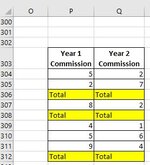Hello, I'm looking to fix the vba code below. Essentially, I'm looking for a vba code to perform the autosum function in each cell in the range that contains the word "Total". The problem with the code below is that the autosum sums everything above it, including the cells with the totals. I am looking for the autosum to only sum the cells above it BUT below the last total calculated. IE
P304 = 2
P305 = Total
P306 = 3
P307 = 7
P308 = 2
P309 = Total
Cell P309 should autosum 3, 7 and 2 only, NOT 2, 2(first Total), 3,7, and 2. The values of the cells are based on formulas which reference a database. Therefore, the word "Total" appears randomly in the range based on the data refresh. Please help!
VBA code:
P304 = 2
P305 = Total
P306 = 3
P307 = 7
P308 = 2
P309 = Total
Cell P309 should autosum 3, 7 and 2 only, NOT 2, 2(first Total), 3,7, and 2. The values of the cells are based on formulas which reference a database. Therefore, the word "Total" appears randomly in the range based on the data refresh. Please help!
VBA code:
- 'change sum in subtotal to formula
- Set sumrange = Range("P304:Q585")
- For Each Cell In sumrange
- If Cell.value = "sum" Then
- Cell.Formula = "=Sum(" & Range(Cell.Offset(-1, 0), Cell.Offset(-1, 0).End(xlUp)).Address & ")"
- End If
- Next






